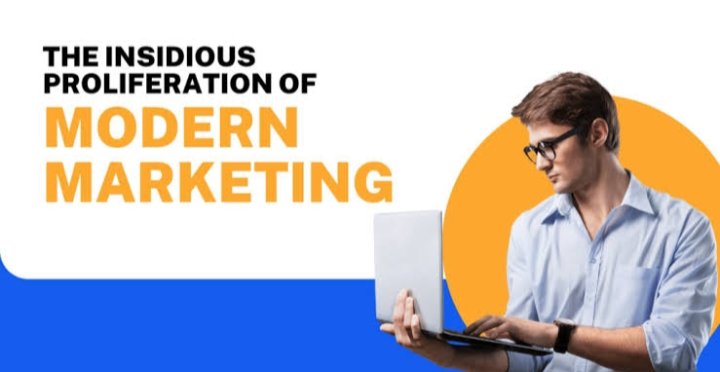In today’s world, it seems like everywhere you look, there’s another advertisement vying for your attention. From social media feeds to billboards, the insidious proliferation of modern marketing is hard to escape. But what does this mean for us as consumers? Is it all bad, or are there some positives we can glean from this barrage of information? In this blog post, we’ll explore the effects of modern marketing, its tactics, and how to navigate this overwhelming landscape without losing our sanity.
Understanding Modern Marketing
What is Modern Marketing?
Modern marketing refers to the tactics and strategies used by companies to promote their products and services in the digital age. This includes social media marketing, email campaigns, influencer partnerships, and targeted advertisements. Unlike traditional marketing methods, which relied heavily on print and television, modern marketing utilizes technology to reach audiences more effectively.
The Evolution of Marketing
Marketing has come a long way since the days of simple newspaper ads. With the rise of the internet, businesses quickly adapted to online platforms, giving birth to modern marketing as we know it today. This evolution has brought both advantages and disadvantages:
- Pros: Businesses can reach a larger audience at a lower cost.
- Cons: The sheer volume of marketing messages can overwhelm consumers.
The Tactics of Modern Marketing
Personalization and Targeting
One of the hallmarks of modern marketing is its ability to target specific demographics. Companies collect data on consumer behavior and preferences to create personalized advertisements. This means you might see ads for products you’ve searched for online, making it feel like marketers are reading your mind.
Why It Works:
- Increased Relevance: Personalized ads are often more appealing because they match your interests.
- Higher Conversion Rates: When consumers feel a connection to the product, they’re more likely to buy.
The Role of Social Media
Social media platforms like Facebook, Instagram, and TikTok have transformed how brands interact with consumers. These platforms allow for direct engagement and can create a sense of community around a product.
- User-Generated Content: Brands often encourage customers to share their experiences, which can build trust and authenticity.
- Influencer Marketing: Companies partner with influencers to reach a wider audience, often with more credibility than traditional ads.
The Downsides of Modern Marketing
Information Overload
While modern marketing can be effective, it can also lead to information overload. With so many brands competing for attention, consumers may feel bombarded by messages, making it difficult to focus on what truly matters.
Manipulative Practices
Some marketing strategies can border on manipulative. Techniques such as fear-based advertising or creating a false sense of urgency (like “limited-time offers”) can pressure consumers into making hasty decisions.
- Emotional Manipulation: Marketers may play on your fears or desires to sell a product, leading to regret after purchase.
- FOMO (Fear of Missing Out): This tactic can drive impulsive buying decisions, leading to buyer’s remorse.
Navigating the Marketing Maze
Tips for Consumers
In a world saturated with marketing messages, it’s essential to arm yourself with tools to navigate the landscape effectively. Here are some tips:
- Be Critical: Question the motives behind the ads you see. Ask yourself if the product truly meets your needs or if it’s just a clever marketing ploy.
- Limit Exposure: Unfollow accounts and unsubscribe from emails that don’t add value to your life. This can help reduce information overload.
- Educate Yourself: Understanding marketing tactics can help you make more informed decisions.
Embrace the Positives
Not all marketing is bad! There are benefits to being aware of modern marketing techniques:
- Informed Choices: With personalized ads, you may discover products that genuinely interest you.
- Community Engagement: Brands that engage authentically can foster a sense of belonging among consumers.
Conclusion
The insidious proliferation of modern marketing can be overwhelming, but understanding its tactics can empower you as a consumer. By being aware of how marketing works, you can make informed choices that align with your values and needs. So the next time you see an ad that grabs your attention, take a moment to consider what’s behind it.
FAQs
1. What is modern marketing?
Modern marketing refers to the strategies and tactics used to promote products and services in the digital age, including social media, email marketing, and targeted ads.
2. How has marketing changed over the years?
Marketing has evolved from traditional methods, such as print ads, to modern techniques that leverage technology and data to reach specific audiences.
3. Why is personalized marketing effective?
Personalized marketing works because it provides relevant content to consumers based on their interests and behaviors, leading to higher engagement and conversion rates.
4. What are some downsides of modern marketing?
Downsides include information overload, emotional manipulation, and pressure to make hasty purchasing decisions.
5. How can I navigate modern marketing effectively?
Be critical of ads, limit exposure to unnecessary marketing messages, and educate yourself on marketing tactics to make informed choices.
